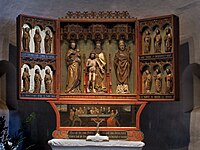
Sylt is an island in northern Germany, part of Nordfriesland district, Schleswig-Holstein, well known for the distinctive shape of its shoreline. It belongs to the North Frisian Islands and is the largest island in North Frisia. The northernmost island of Germany, it is known for its tourist resorts, notably Westerland, Kampen and Wenningstedt-Braderup, as well as for its 40-kilometre-long (25-mile) sandy beach. It is frequently covered by the media in connection with its exposed situation in the North Sea and its ongoing loss of land during storm tides. Since 1927, Sylt has been connected to the mainland by the Hindenburgdamm causeway. In later years, it has been a resort for the German jet set and tourists in search of occasional celebrity sightings.
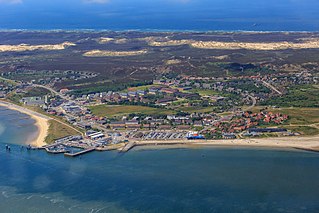
List auf Sylt is the northernmost municipality in Germany, located on the North Sea island of Sylt close to Denmark in the district of Nordfriesland in the state of Schleswig-Holstein.

is a municipality and seaside resort on the island Sylt, in the district of Nordfriesland, in Schleswig-Holstein, Germany. It is located north of the island's main town, Westerland. The municipality is part of the AmtLandschaft Sylt. The local economy is dominated by tourism.

Wenningstedt-Braderup is a municipality and seaside resort on the island of Sylt in the district of Nordfriesland, in Schleswig-Holstein, Germany. It is located north of the town of Westerland and is part of the Amt Landschaft Sylt. The local economy is dominated by tourism.
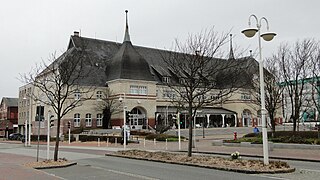
Gemeinde Sylt is a municipality on the island of Sylt in the district of Nordfriesland, in Schleswig-Holstein, Germany. It has around 13,000 inhabitants and covers about 60% of the area of the island.

St. Canute's Church is a Romanesque church located 3 km northeast of Rønne on the Danish island of Bornholm.

The Harhoog is a dolmen, a rectangular megalithic tomb from the Funnelbeaker culture, located near Keitum on the island of Sylt in Schleswig-Holstein, Germany. Discovered in 1925, it was moved to the present site in 1954 when a new airport was developed.

Stubbekøbing Church is located in Stubbekøbing some 18 km (11 mi) northeast of Nørre Alslev on the Danish island of Falster. The basilical nave was built of limestone in the Late Romanesque period. Choir and tower are of brick, the choir built in Early Gothic style, tower and the northern chapels in the 15th century in Late Gothic style. In addition to its Renaissance altarpiece and pulpit, it has a variety of old frescos and wall decorations (1300–1500).

Eskilstrup Church is a church in Eskilstrup, Denmark. The church dates from the 12th century and was built in the Romanesque style. In accordance with a local tradition, it is painted red. It is best known for its frescos, said to be Denmark's oldest.
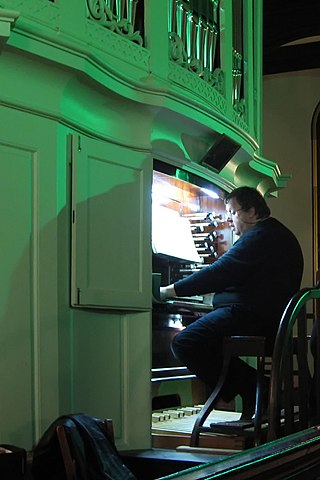
Matthias Eisenberg is a German concert organist and harpsichordist, and a cantor. The award-winning player is known for performing concerts with clarinetist Giora Feidman. He has performed and conducted master classes internationally. He recorded, including the complete organ works by J. S. Bach and improvisations, and has conducted Bach cantatas from the harpsichord in collaboration with the Thomanerchor.

Toreby Church is the parish church of Toreby on the Danish island of Lolland. It is an unusually large red-brick Romanesque building, the nave and chancel having been extended in the Gothic period with a sacristy and lateral aisle. The tower is late Romanesque. There are frescos from c. 1400 in the sacristy. The carved pulpit (1645) is the work of Jørgen Ringnis.

Østofte Church, located in the village of Nørreballe on the Danish island of Lolland, was built in the 14th century. The Romanesque apse, chancel and nave formed the original building while the tower and porch were added in the Late-Gothic period and the north wing was completed in 1656.
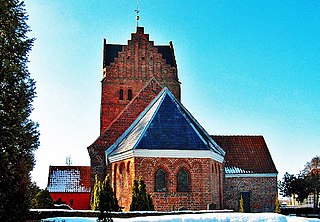
Stokkemarke Church is located in the village of Stokkemarke some 11 km (6.8 mi) northwest of Maribo on the Danish island of Lolland. Dating from the middle of the 13th century it was built in the Romanesque style with later additions in the Gothic period.
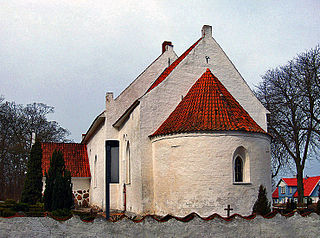
Arninge Church is a Late Romanesque church in the little village of Arninge, some 8 km (5.0 mi) south of Nakskov on the Danish island of Lolland. Built of red brick in the 13th century, it has an intricately carved auricular altarpiece created by Henrik Werner in 1644.
Archsum is a village on the North Sea island of Sylt in the district of Nordfriesland in Schleswig-Holstein, Germany. Today, it is an Ortsteil of the Gemeinde Sylt.
Morsum is a village on the North Sea island of Sylt in the district of Nordfriesland in Schleswig-Holstein, Germany. Today, it is an Ortsteil of the Gemeinde Sylt. Morsum is located close to the scientifically important geotope Morsum-Kliff and to the beginning of the Hindenburgdamm linking Sylt with the mainland.
Munkmarsch is a village on the North Sea island of Sylt in the district of Nordfriesland in Schleswig-Holstein, Germany. Today, it is an Ortsteil of the Gemeinde Sylt.

Keitum is a village on the North Sea island of Sylt in the district of Nordfriesland in Schleswig-Holstein, Germany. Today, it is an Ortsteil of the Gemeinde Sylt.
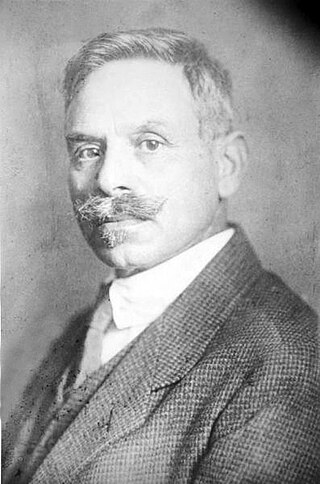
Franz Korwan, born Sally Katzenstein was a German-Jewish landscape painter and Kommunalpolitiker on the island of Sylt. He was associated with the Düsseldorfer Malerschule. Sally is the familiar form of Salomon. His name change was legally recognized in 1924.

Ingo Kühl is a German painter, sculptor and architect.




